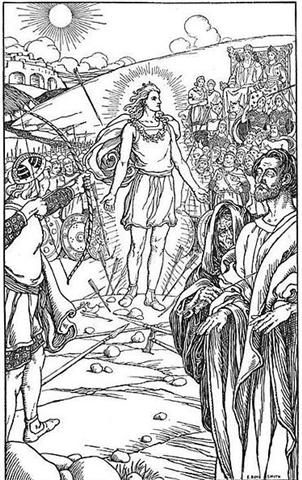5. Probably the myth about the death of Balder has to do with the end of the 'year':
The name Balder sounds as a variant of Baldah (in the name Al Baldah for π Sagittarii). The circumstances around his death is a further connection. "... the interpretation of Baldr as 'the brave god' may be secondary. Baltic (cf. Lithuanian baltas, Latvian balts) has a word meaning 'the white, the good', and Grimm speculates that the name may originate as a Baltic loan into Proto-Germanic. In continental Saxon and Anglo-Saxon tradition, the son of Woden is called not Bealdor but Baldag (Sax.) and Bældæg, Beldeg (AS.), which shows association with 'day', possibly with Day personified as a deity which, Grimm points out, would agree with the meaning 'shining one, white one, a god' ..." (Wikipedia) "He had a dream of his own death and his mother had the same dreams. Since dreams were usually prophetic, this depressed him, so his mother Frigg made every object on earth vow never to hurt Baldr. All objects made this vow except mistletoe. Frigg had thought it too unimportant and nonthreatening to bother asking it to make the vow (alternatively, it seemed too young to swear). When Loki, the mischief-maker, heard of this, he made a magical spear from this plant (in some later versions, an arrow). He hurried to the place where the gods were indulging in their new pastime of hurling objects at Baldr, which would bounce off without harming him. Loki gave the spear to Baldr's brother, the blind god Höðr, who then inadvertently killed his brother with it (other versions suggest that Loki guided the arrow himself). For this act, Odin and the giantess Rindr gave birth to Váli who grew to adulthood within a day and slew Höðr." (Wikipedia) Balder was killed by mistletoe and this points at Hercules, we know: ... He carries an oak-club, because the oak provides his beasts and his people with mast and because it attracts lightning more than any other tree. His symbols are the acorn; the rock-dove, which nests in oaks as well as in clefts of rocks; the mistletoe, or Loranthus; and the serpent. Spring Sun (Hercules) is taking his revenge at winter solstice, we can conclude. However, according to The White Goddess the pair of antagonists were Balder and Höðr (Holder): "That the Goddess Frigga ordered a general mourning for Balder incriminates her in his death. She was really Nanna, Balder's bride, seduced by his rival Holder; but like the Egyptian priests of Isis, the Norse scalds have altered the story in the interests of marital rectitude." The blind one ought to refer to the dark part of the year and the shining one to the light part. This division of the year is not the same as that between the first and the second halves of the year (defined by the solstices). Thus the death of Balder ought to come earlier than winter solstice, possibly at the heliacal rising of Nusakan. The division of the year into 'leaf' and 'straw' does not have to be symmetric. But the Sign of the mistletoe seems to put the death of Balder at winter solstice, close to Christmas (the only time when nowadays the mistletoe is appreciated). But The White Goddess tells another story: "On midsummer day, in ancient Europe, the Eye of the year was blinded with a mistletoe stake, all the other trees (according to the Norse legend) having refused to do so. The Church now admits holly and ivy as reputable church decorations at Christmas, but forbids the mistletoe as pagan. However, mistletoe cannot be ousted from its sovereignity of Midwinter, and the exchange of kisses forbidden at all other seasons is still permitted under its bough, if it has berries on it. Chemists have tried to learn how mistletoe won the name 'all-heal', by analyzing its alkaloids. They can find none of any curative virtue, though this is not final proof of the mistletoe's medicinal valuelessness. Camomille, for example, had medicinal properties, but no extractable alkaloid. A plant is rarely awarded mystic virtue unless it has some property beneficial to man. Yet, the spectacle of green leaves and white berries on an otherwise bare tree may have been sufficiently odd to invest them with supernatural powers. The wood, by the way, is extremely hard and tough, mistletoe being slow-growing; Haedury's mistletoe spear which pieced Balder's gentle breast in the legend was no poetic fancy - I once cut one for myself in Brittany. This calendar [the Beth-Luis-Nion solar tree calendar] explains the reference in Gwion's Preiddeu Annwm to the 'ox with seven-score knobs on his collar': the ox is the first flight of five months, consisting of 140 days; it is presumably followed by a lion of one hundred and twelve days [16 weeks], and a serpent of the same length, to justify the two texts already quoted ... from Euripides and the Welsh poet Cynddelw - both appealing to the God of the year to appear as a wild bull, a fire-breathing lion and a many-headed snake. The griffon-eagle must be the creature of the extra day, since the god becomes immortal in this form. This year of Bull, Lion, Serpent and Eagle is Babylonian: a calendar beast, called Sir-rush, on the Dragon Gate at Babylon having the body and horns of a bull; forelegs and mane of a lion; head, scales and tail of a serpent; hindlegs and feet of an eagle."
Once the end of the year was not in midwinter but at midsummer. |

